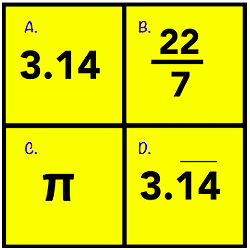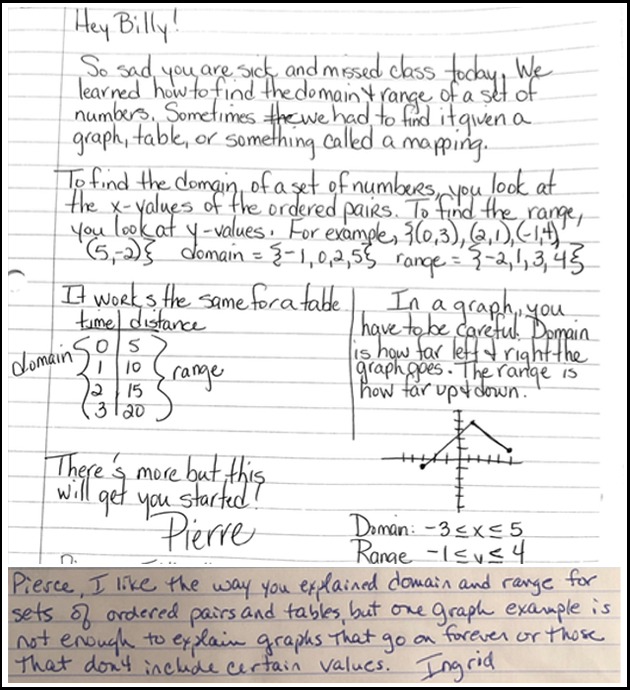Beyond the Right Answer: Assessing Student Thinking
Welcome to a classroom located in Anywhere, U.S.A.
Teacher: “What’s the answer to #5?”
Student A: “12!”
Teacher: “Correct! How about the answer to #6?”
Student B: “3!”
Teacher: “Nice! #7?”
Student C: “-4”
Teacher: “Not quite. Anyone else?”
Student A: “4”
Teacher: “Excellent! #8?”
This continues until all the answers have been given. Because the students are giving the right answers, the teacher assumes all students understand — even those giving the correct answers. What if we look underneath the correct answer? Is the student’s thinking correct? Is he using an appropriate strategy, or is his thinking flawed in some way even though it yields the correct answer in certain situations?
For example, let’s look at what happened in my classroom.

When I asked Sarah how she arrived at the answer, she was able to accurately show me the graph she created and how she knew that the x-intercepts she found were the solutions to the equation. Joey, on the other hand, gave a detailed explanation as to how he solved the equation to find the right answer. However, when prodding him a bit more by asking how he would solve the problem using his method if a 2 was placed in front of the first term, Joey had no idea what he would do. The “trick” he was using was only valid for solving quadratic equations with a lead coefficient of 1. He wasn’t even sure why his method worked. By taking the time to dig into the student’s correct answers, I was able to uncover Joey’s misconception before we continued blindly down the learning path.
When we look at assessing student thinking beyond the right answer, we are really examining feedback. While feedback can come from teachers and/or peers, it is information given to the learner about the learner’s performance relative to learning goals or outcomes that aims toward (and is capable of producing) improvement in students’ learning. Now that’s a mouthful. Right?
Feedback boils down to anything we say to a student or anything a student says to a teacher or to other students. What we want to accomplish is to elicit high-quality academic feedback from students by modeling high-quality academic feedback to them so they can provide it to their peers. According to John Hattie’s research, the most impactful feedback (.70 effect size) is shared between students.
To achieve high-quality, student-to-student academic feedback, we must first set the stage in our classrooms. We must provide a risk-free environment where students feel safe in sharing their thinking — a space that embraces failing forward and is free from ridicule when making mistakes. It takes intentionality and time to create this type of responsive environment where students own and eagerly display their thinking without fear of reproach. To create a thinking classroom, I started each class with a low-floor, high-ceiling task where there are no incorrect answers. This provided access to each day’s lesson, affording all students the opportunity to engage with the task and justify their answers. My job was simply to facilitate the discussion. At the beginning of one class, I used the activating strategy “Which One Doesn’t Belong” with my students.
Which one doesn’t belong? Why?

It’s easy to poll students for the answers they chose. “How many of you chose A? B? C? D?” If I had left it right there, I would not have elicited any student thinking. Instead of settling for the poll to capture the number of correct responses, I asked, “Who eliminated C?” Followed by, “Why did you choose C? Who else chose C for the same reason? Who chose C for a different reason?” Students explaining their rationales revealed their levels of understanding. For example, one student’s response was, “I chose C because it’s the only symbol. The rest are numbers.” Another student justified eliminating C by saying, “I chose C because it’s the only irrational number of the four.” I provided feedback by asking questions to elicit their thinking. Students’ feedback to me was a justification for their thinking. By doing this, I could clearly see the different levels of understanding in my class, and all students benefited from hearing the justifications of others. This helps others see the problem from a different perspective and opens them up to different ways to solve a problem
In addition to the “Which One Doesn’t Belong” routine, there are other routines that are low-floor, high-ceiling that invite student engagement and discourse, including:
Once a safe environment has been achieved, the stage is set to focus on helping students learn to provide meaningful feedback. It all starts with us, the teachers. While setting the stage, we are modeling what good feedback sounds like. We must be mindful that what we say can either lead a student to open up or to completely shut down. We must make certain that right answers get as much feedback as incorrect answers. Remember, students learn by hearing the thinking of others. We also need to make sure that the feedback is specific. For example, “Great answer!” does not provide the student much information. The student and others are wondering what was so great about the answer. Because we are eliciting more than just the answer from the student, we can say, “Great answer! I like the way you used your calculator to confirm the solution to your equation graphically.” Now everyone is clear as to what you think is so great.
Moving from teacher-to-student and student-to-teacher feedback to highly effective student-to-student feedback can be tricky. We have to provide opportunities for students to give each other feedback as well as structures to help get them started. For example, I supplied my students with some peer conversation stems to help them initiate feedback to other students (see below). We added to this list as the year progressed.
![Peer conversation stems included the following questions: 1. How do you know? Justify your answer. 2. When you said [blank], I understood [blank]. 3.I like what [blank] said because [blank]. 4. I agree with [blank], because [blank]. 5. Could you show me? 6. I still have a question about [blank]. 7. I noticed that [blank]. 8. I wonder [blank]. 9. Could you give me an example of [blank]? 10. Who else could we ask about [blank]?](/-/media/ti/education/images/bulletin-board/blog/blog_images/30773-feb-17-assessing-students/peer-conversation-stems.png)
In addition, I gave opportunities for students to provide written feedback to each other on which I provided feedback to both students. A good way to do this is to have each student write a letter in his or her own words to an absent student or a new student explaining the content we learned that day. Once everyone’s letter was complete, I collected all and redistributed them to the students who would then provide written feedback to the original student based on the rubric. Journal entries like this can be used to initiate feedback between students until they are comfortable sharing aloud.

As the year progressed, my students owned their mistakes. Often, when we would discuss an anonymous incorrect answer, a student would pipe up and say, “That is my work, and here’s what I was thinking. …” What more could a teacher ask for?
I hope you will check out the webinar that Janice Mitchener and I presented if you want to learn more about assessing students beyond the right answer. In the on-demand version of the webinar, we fully discuss creating a safe environment, each type of feedback, strategies for eliciting feedback, and how to set the stage for a successful year filled with high-quality feedback. Be brave! Dive into a student’s thinking beyond the right answer. You’ve got this!
About the author: Sherri Abel is a retired math teacher who lives in Charleston, South Carolina, and enjoys soaking up Vitamin D on the beach as often as possible. Although retired, she still loves working with TI to provide resources, facilitate conference sessions and webinars, as well as support districts and teachers in implementing high-quality math curriculums. After 35.5 years in education, Abel retired in December of 2021 as the District Instructional Specialist for Secondary Mathematics in the Charleston County School District. Abel is a T³™ National Instructor and remains active in state and national math organizations.
Tagcloud
Archive
- 2025
- 2024
-
2023
- January (3)
- February (3)
- March (5)
- April (3)
- May (3)
- June (3)
- July (2)
-
August (6)
- 5 Ways to Spruce Up Your Classroom for Back to School
- Day of the Dog: Which Dog Is Roundest?
- Women Who Code: A TI Intern’s Fascinating STEM Journey
- 6 Sensational TI Resources to Jump-Start Your School Year
- 3 Back-to-School Math Activities to Reenergize Your Students
- A New School Year — A New You(Tube)!
- September (2)
- October (3)
- November (1)
- 2022
-
2021
- January (2)
- February (3)
- March (5)
-
April (7)
- Top Tips for Tackling the SAT® with the TI-84 Plus CE
- Monday Night Calculus With Steve Kokoska and Tom Dick
- Which TI Calculator for the SAT® and Why?
- Top Tips From a Math Teacher for Taking the Online AP® Exam
- Celebrate National Robotics Week With Supervised Teardowns
- How To Use the TI-84 Plus Family of Graphing Calculators To Succeed on the ACT®
- AP® Statistics: 6 Math Functions You Must Know for the TI-84 Plus
- May (1)
- June (3)
- July (2)
- August (5)
- September (2)
-
October (4)
- Transformation Graphing — the Families of Functions Modular Video Series to the Rescue!
- Top 3 Halloween-Themed Classroom Activities
- In Honor of National Chemistry Week, 5 “Organic” Ways to Incorporate TI Technology Into Chemistry Class
- 5 Spook-tacular Ways to Bring the Halloween “Spirits” Into Your Classroom
- November (4)
- December (1)
-
2020
- January (2)
- February (1)
- March (3)
- April (1)
- May (2)
- July (1)
- August (2)
- September (3)
-
October (7)
- Tips for Teachers in the time of COVID-19
- Top 10 Features of TI-84 Plus for Taking the ACT®
- TI Codes Contest Winners Revealed
- Best of Chemistry Activities for the Fall Semester
- Best of Biology Activities for the Fall Semester
- Best of Physics Activities for the Fall Semester
- Best of Middle Grades Science Activities
- November (1)
- December (2)
- 2019
-
2018
- January (1)
- February (5)
- March (4)
- April (5)
- May (4)
- June (4)
- July (4)
- August (4)
- September (5)
-
October (9)
- Art in Chemistry
- Which Texas Instruments (TI) Calculator for the ACT® and Why?
- Meet TI Teacher of the Month: Jessica Kohout
- Innovation in Biology
- Learning With Your Students
- A first-of-its-kind STEM strategy charts path to help educators
- #NCTMregionals Hartford 2018 Recap
- The Math Behind “Going Viral”
- Real-World Applications of Chemistry
-
November (8)
- Testing Tips: Using Calculators on Class Assessments
- Girls in STEM: A Personal Perspective
- 5 Teachers You Should Be Following on Instagram Right Now
- Meet TI Teacher of the Month: Katie England
- End-of-Marking Period Feedback Is a Two-Way Street
- #NCTMregionals Kansas City 2018 Recap
- Slope: It Shouldn’t Just Be a Formula
- Hit a high note exploring the math behind music
- December (5)
- 2017
- 2016
- 2015
